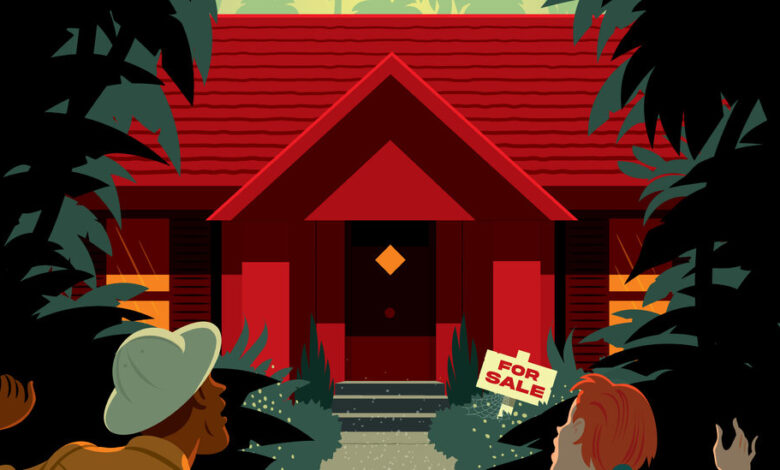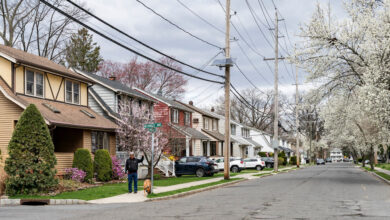Finding a Home in This Overheated Market

[ad_1]
Peggy Bellar, a real estate agent in the western Catskills hamlet of Margaretville, N.Y., recalls the languid days of two years ago, when houses sat on the market an average 200 days before they were sold.
“Now we put up a listing on Wednesday morning and typically have it fully in contract with multiple bids by Sunday evening,” Ms. Bellar said. “So when a listing is taking longer or not getting the level of activity expected, we naturally wonder why.”
In this manic market with its slim pickings, a harsh light is cast on houses that do not sell right away. Within weeks, the leftover is tainted. It sinks to the bottom of Zillow and Realtor searches. Buyers note the paltry agglomeration of “views” and “saves” and ask, “What’s wrong with it?”
A better question may be: Is there an opportunity here that others overlook?
“If a house has been hanging on the market for over 90 days it’s quite possible you’ll get a real value purchase out of it,” said Dale F. Stewart, a salesperson at Houlihan Lawrence in Millbrook, N.Y.
Ms. Stewart said she is working with a buyer who has an accepted offer on a property just outside Hudson, N.Y., in Columbia County, that has been listed for more than a year. “It’s a true diamond-in-the-rough parcel with a few dilapidated outbuildings,” she said. “My client has a vision and is able to see past what previous buyers could not.” The offer is about $100,000 below the asking price of $575,000.
According to the dozen agents in New York, New Jersey and Connecticut who were interviewed for this article, houses languish on the market for both obvious and mysterious reasons. The property may be close to a busy road or cemetery. It may have a sagging roof or a tiny lot. The style may be an unfashionable log cabin or split-level rather than a chic, modern farmhouse or cottage. The interior may look dated (dark-toned and compartmentalized) rather than up-to-the-moment (flowing and white).
In this age of online marketing and sight-unseen purchases, a house might also fail to sell quickly if it has been staged and photographed poorly, or if the photos exaggerate room sizes or retouch flawed surfaces, so that buyers are disappointed when they do turn up for a showing.
“As 99 percent of listings are viewed online, photos are very important,” said Kyle Hinding, of Coldwell Banker Realty in Essex, Conn. “Some agents still refuse to use a photographer and I feel it’s to the detriment of the seller.”
Even when pictures are professional, the story they tell may not be flattering. For instance, nothing says a house has been passed over like the image of a snowy lawn in June. A 1989 Tudor on three pastoral acres in the Dutchess County town of Milan, N.Y., has squatted on the market since December, with 11 price decreases from its original ask of $925,000. Why? The listing agent at Gary DiMauro Real Estate declined to comment, but the current photos showing bare trees and a covered in-ground swimming pool do it no service. (The current price, by the way, is $699,000.)
While real estate agents agree on the importance of marketing, they are divided on other features that might keep a property from rushing into contract. Like a location on a highly trafficked road. In rural mountain areas, Ms. Bellar pointed out the convenience of town-maintained roads that provide access to shopping and services, especially in winter. Amy Samett, a sales associate at Ellis Sotheby’s International Realty in Nyack, N.Y., said she would have rated a busy road higher on the list of drawbacks before the pandemic, “but it seems to be less of a factor now. Maybe because so many people are coming from the city, the noise is not as much of an issue?”
The interior styling of laggard properties can be off-putting or set the imagination on fire. Ms. Hinding had to talk reluctant clients into looking at a three-bedroom ranch house in Ivoryton, Conn. It needed “all cosmetics” and had an ugly above-ground pool, she said, “but the sellers had done all the heavy lifting: roof, furnace, hot water heater and central air.” Her clients paid a little less than the asking price of $317,000 and were treated to septic system repairs and asbestos remediation. (Shoppers looking for bargains should take note when the listing displays a single, exterior photo, as this one did. When interiors are out of sight, the buyer seeking a turnkey property is probably out of luck.)
Ms. Stewart described a $650,000 house in Kinderhook, N.Y., in Columbia County, which has been on the market for more than 275 days, as a “’70s love shack — it’s wall-to-wall carpet and super dated, but jeez, it could rock with $100,000 in.”
Other impediments to a sale are not readily visible.
It could be an owner who is emotionally attached to a home and repeatedly cancels contracts, or an owner who is willing to wait months or years for the “right buyer” to show up and pay whatever is asked.
In the case of a custom-built four-bedroom house on 64 acres near Cooperstown, N.Y., which has been on and off the market since April 2019 and is currently listed for $549,000, the sticking point is the lack of high-speed internet. “It’s just outside an area that has already gotten fiber optic cable,” said Hazen Reed of Keller Williams upstate New York Properties, who shares the listing with his business partner and wife, Susan Muther. Mr. Reed expects the service soon, but unless buyers know they can have it right away, “they’re nervous about taking the next steps.” (On the plus side, they have not seemed fazed by the home’s unsavory-sounding street name: Bedbug Hill Road.)
And some stubborn listings are simply unexplainable. “I can’t figure it out,” said Catherine A. Mondello, a broker in Dutchess County, about a 1950s ranch house in Hyde Park, N.Y. Priced at $369,000, the house has been sitting for more than two months. “It’s very neat, very well maintained,” Ms. Mondello went on. After showing it a dozen times, the only negative feedback was a wish that it was bigger. “I think it’s just waiting for the right person,” she said.
Agents say that ultimately, the three things that determine whether a house sells quickly are: price, price, price.
“Proper pricing is key not only for selling a slow-moving property, but also for getting the optimal price for any property in a seller’s market,” Ms. Bellar said. Or as Ms. Stewart put it, “Buyers are chomping at the bit, but they’re not stupid.”
Sandi Park, an associate broker with Berkshire Hathaway Home Services in Dutchess County, routinely counsels sellers to handle transactions “with grace and fair pricing.” She warned that any buyer — even a highly motivated one with a wheelbarrow of cash — resents being gouged in a pandemic. And with house prices at an all-time high and Covid restrictions easing, she said, “people are becoming sensitive to the question: ‘what if the market adjusts? Am I going to be holding an overpriced potato?’”
So when Ms. Park was pricing a house in Millbrook, N.Y., that needed updating but sat on a quiet country road on five bucolic acres, she listed it at $287,000 and had 62 showings and 32 offers. “The house is selling for way over asking price,” she said, declining to give the figure because it hadn’t closed yet. A comparable house in Millbrook, with far less acreage, was listed in May for $310,000, reduced in June to $299,999 and is still for sale.
For buyer clients, Ms. Park looks intensely at houses that have been sitting like lumps, including those for sale by their owners and even listings that have been withdrawn. If she spots a rough gem, she jumps in and offers a lower price before the seller makes a formal reduction online that triggers multiple bids. “I just got a client into a deal for $35,000 under asking that very way,” she said. Her clients call her “Swoop Sandi.”
When it comes to pricing, third-party websites like Zillow and Realtor offer useful transparency (to a point), but also contribute to the problems of sluggish properties, agents say. Buyers see a house’s sales history and draw their own conclusions about why a price has been reduced. But sometimes the story is more complicated than a few stats suggest, and the agent may never get a chance to explain it. Zillow’s habit of reporting how many people look at or save a listing further shapes negative perceptions. If the numbers are skimpy, viewers might assume something is wrong and move on.
Then again, a house that isn’t smothered with interest has its own charms. If enthusiasm for a home is dampened, Peggy Bellar in Margaretville said, it may be for no other reason than buyer fatigue. “Lots of people have been in numerous competitive bidding situations and are gun shy at this point.”
Ms. Bellar had one final explanation for a moribund listing: “when everything has been done correctly” (including the all-important pricing), then it “may simply be a factor of the real estate market adjusting slightly.”
For weekly email updates on residential real estate news, sign up here. Follow us on Twitter: @nytrealestate.
[ad_2]
Source link






